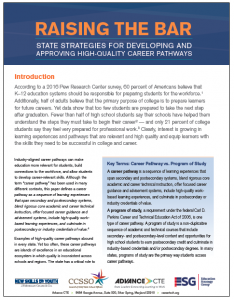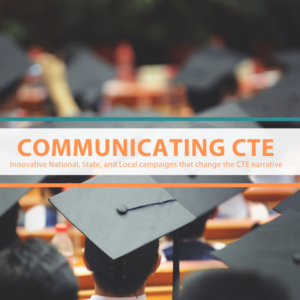
The third post in the Communicating Career Technical Education (CTE) series will focus on creative initiatives for career exploration for secondary learners by highlighting Washington’s State of Innovation Challenge. This is particularly timely as states continue to grapple with the difficulties of supporting long-term career exploration experiences in an environment of sustained uncertainty and student disconnect in virtual learning environments.
Background
The State of Innovation Challenge, launched in November 2020 and open through March 2021, is a statewide initiative led by the Washington’s STEM Education and Innovation Alliance in partnership with the Office of Governor Jay Inslee, the Superintendent of Public Instruction, and Career Connect Washington. The initiative invites learners to offer solutions to policy issues related to hunger, mental health and community resilience that have emerged from the COVID-19 (coronavirus) global pandemic while also exploring pathways to careers and postsecondary education.
Becky Wallace, Executive Director of Career and Technical Education at the Washington Office of the Superintendent of Public Instruction, shared that her office was inspired to join this initiative because of the widespread evidence that instructors were overwhelmed with the transition to virtual learning and did not have the capacity to fill the void of a lack of hands-on learning. The things that make CTE unique including work-based learning, real-world skill attainment and application have been challenging to replicate in a hybrid and virtual environment. As such, the Office saw this as an opportunity to elevate project-based and experiential learning for learners in all types of programs, empower the learner voice and leverage statewide resources to expand the career path students can name and see as a possible passion.
The initiative proposes challenge cases covering three major policy areas questions:
- “The Food Chain”: Facilitating access to healthy, affordable and sustainable food during the pandemic, particularly for households that experience low income.
- “Responding to COVID-19”: Supporting the mental health of teens and the elderly
- while practicing social distancing, and ensuring access to accurate information about coronavirus and its spread while protecting privacy.
- “Our Communities after COVID-19”: Building more resilient communities in the aftermath of COVID-19 through improvements to housing, education, community planning and economic policy.
More detailed subtopics are given for each challenge case that can be aligned to CTE programs. For example, learners that choose the Food Chain case can develop projects addressing school nutrition, food waste, food production or restaurant and hospitality impacts that connect to the associated career pathways.
Learners in middle school, high school, alternative education and out of school youth programs are able to participate. The initiative is also accessible for programs beyond the traditional classroom setting such as Career Technical Student Organizations (CTSOs), community organizations such as 4-H Washington and Junior Achievement, and specialized programs like the Road Map Project that supports homeless and foster youth.
Julia Reed, Senior Consultant for social impact consulting firm Kinetic West that guided the formation and implementation of the initiative, shared that the biggest concern was convincing educators that this initiative could enhance, not burden, their virtual instructional goals. Flexibility and variety in lesson plan offerings were prioritized to make sure the initiative was easy to participate in and would enhance student engagement in their classroom.
In the Classroom
After choosing a challenge case, students and educators take several steps to develop a policy solution: viewing videos created by teen filmmakers connected to each policy question; selecting one of the provided subtopics for their chosen challenge case; exploring careers associated with the policy area; and executing a lesson plan and policy tool that can range from one day to one or more months in duration.
The project solutions themselves encourage exploration and skillbuilding across a variety of career pathways, as students are allowed to record videos, create apps, design websites and computer programs, write business plans and more as part of a proposed solution. Educators are provided instructional guides for each challenge to assist building lesson plans, and are able to share their lessons through a group lesson bank and submit final projects for state recognition.
Students are able to directly interact with employers and learn about career pathways within industries through virtual weekly industry engagement webinars. Past employer engagement sessions include interactions with high-tech manufacturers, firefighters and government agencies all based within Washington.
Exploring Postsecondary Pathways
Students are able to build on their exploration of policy, skillbuilding activities and careers by researching postsecondary opportunities for further education. Rather than recreating the wheel, this initiative elevates pre-existing state college preparation and financial aid resources, including Career Connect Washington’s Career Launch paid learning program, Washington College Access Network’s College Knowledge Materials with handbooks in five languages for grades 9 to 12 on planning for a postsecondary education path, and Washington Student Achievement Council’s Ready, Set Grad step by step online portal.
Marketing and Equity Considerations
Reed emphasized that marketing this initiative focused on building sustainable partnerships and reaching underserved populations by utilizing existing peer-to-peer networks. More than 40 organizational partnerships were established with additional intentional outreach to underserved communities, particularly learners of color, learners in rural communities, and Native American learners.
Equity was a major consideration not only in marketing but the design of the initiative itself. Several strategies pursued include:
- The creation of a general secondary educator advisory group and an ‘open doors’ educator advisory group to ensure project utility for all learners;
- Industry engagement recruitment seeks to feature employers and career paths that would be relevant to students in more remote rural communities;
- Challenge case videos intentionally pursued diverse casting and script copy that emphasized the unequal distribution of impact of coronavirus on different communities;
- Submission criteria for challenge projects includes an equity category: “You’ve thought about how this problem impacts people of different races or ethnicities, genders, abilities or income in different ways. How does your solution help address those different impacts?”
This initiative reflects the enormous potential of states to scale up local efforts to connect learning to work and bring these experiences to more learners. Additionally, the inclusion of lesson plans and engagement opportunities provides timely support for educators and local systems that face unprecedented burdens in coronavirus response.
Additional information and resources for this initiative can be found on the State of Innovation website.
Communicating CTE is a new series where Advance CTE is exploring how states are leading the way in communicating about the value and benefit of CTE to key stakeholders. Read the previous posts in this series.
Stacy Whitehouse, Senior Associate Communications and State Engagement


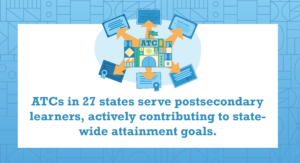 Advance CTE’s recent report on area technical centers (ATCs),
Advance CTE’s recent report on area technical centers (ATCs), 
 Through NSFY, Delaware, Kentucky, Louisiana, Massachusetts, Nevada, Ohio, Oklahoma, Rhode Island, Tennessee and Wisconsin took action to:
Through NSFY, Delaware, Kentucky, Louisiana, Massachusetts, Nevada, Ohio, Oklahoma, Rhode Island, Tennessee and Wisconsin took action to:
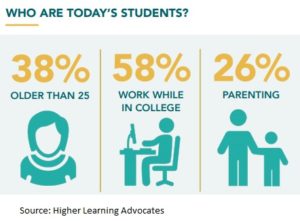 While most people think of the typical college student as coming directly from high school, the reality is that
While most people think of the typical college student as coming directly from high school, the reality is that 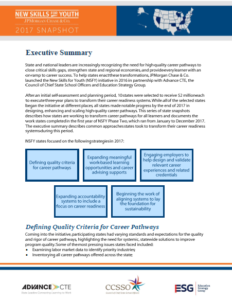 What defines a high-quality career pathway? Is it alignment to labor market needs and career opportunities? The quality and qualifications of teachers and faculty? Access to meaningful, aligned work-based learning experiences? Perhaps all of the above?
What defines a high-quality career pathway? Is it alignment to labor market needs and career opportunities? The quality and qualifications of teachers and faculty? Access to meaningful, aligned work-based learning experiences? Perhaps all of the above? 